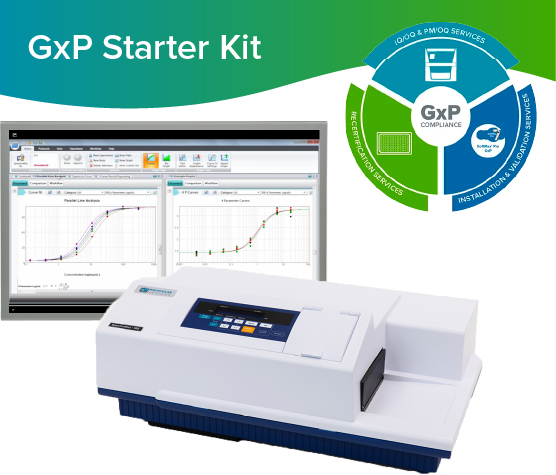Dual monochromators increase performance and assay flexibility
The SpectraMax® M Series Multi-Mode Microplate Readers measure UV and visible absorbance, fluorescence, luminescence, fluorescence polarization, TRF and HTRF. Standard features include a cuvette port, spectral scanning in 1 nm increments, and up to six wavelengths per read. These robust readers have been placed in labs from Antarctica to the International Space Station. With optimized reagents, validation tools, and industry-leading SoftMax® Pro Software, they provide consistent performance.

Assay flexibility
The optical system uses two scanning monochromators so you can determine optimal excitation and emission settings, resulting in assay performance similar to that of dedicated single-mode readers.

Better absorbance accuracy
Measure sample depth with no temperature dependency using the PathCheck Sensor technology. It automatically normalizes absorbance readings to 1 cm, eliminating the need for standard curves.

Increased throughput
Integrate easily with our StakMax® Microplate Stacker for walk-away automation. The stacker can hold up to 50 plates and can be configured to include a barcode reader.
Features

Patented optimization
The patented AutoPMT optimization of the SpectraMax M5 reader adjusts the fluorescence detector to each sample well's concentration and normalizes the raw data, extending the dynamic range of assays.

IQ/OQ/PM Services
Qualify Molecular Devices microplate readers in GLP or GMP environments with our IQ/OQ/PM Services to preserve the documentation of services in a compliant format that can be accessed remotely.

Validation tools
Extensive suite of validation tools reduces the cost and time of validation by 50% as compared to using multiple platforms to collect and analyze data.

Compliance software
SoftMax Pro GxP Software extends data acquisition and analysis solution into regulated laboratories working under GMP, GLP, and 21 CFR Part 11 for secure electronic records.
Kickstart your compliance journey with our “GxP Starter Kit”

For researchers working in GLP or GMP laboratories, achieve full GxP compliance with our turnkey solution:
- SpectraMax M-Series Microplate Reader are modular and upgradeable with a wide range of high performance capabilities.
- SoftMax® Pro 7.2 GxP Software – The latest, most secure software to achieve full FDA 21 CFR Part 11 and EudraLex Annex 11 compliance with streamlined workflows to ensure data integrity.
- SoftMax® Pro Validation Package – Provides the most comprehensive documentation and tools available to validate GxP administrator features, software operation, and analysis functions for microplate reader instrumentation.
- Software Installation & Training – Our software installation services verify and document that required components are installed to operational specifications.
Latest Resources
Featured Applications
Customer Breakthrough
Applications of SpectraMax M Series Multi-Mode Microplate Readers
Specifications & Options of SpectraMax M Series Multi-Mode Microplate Readers
*Using lowest settings and speed read when available.
Download Brochure


